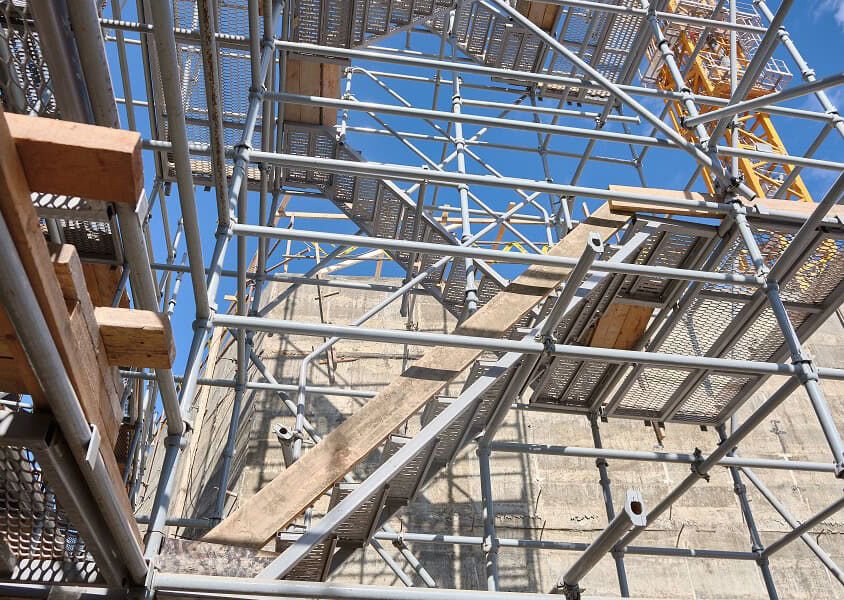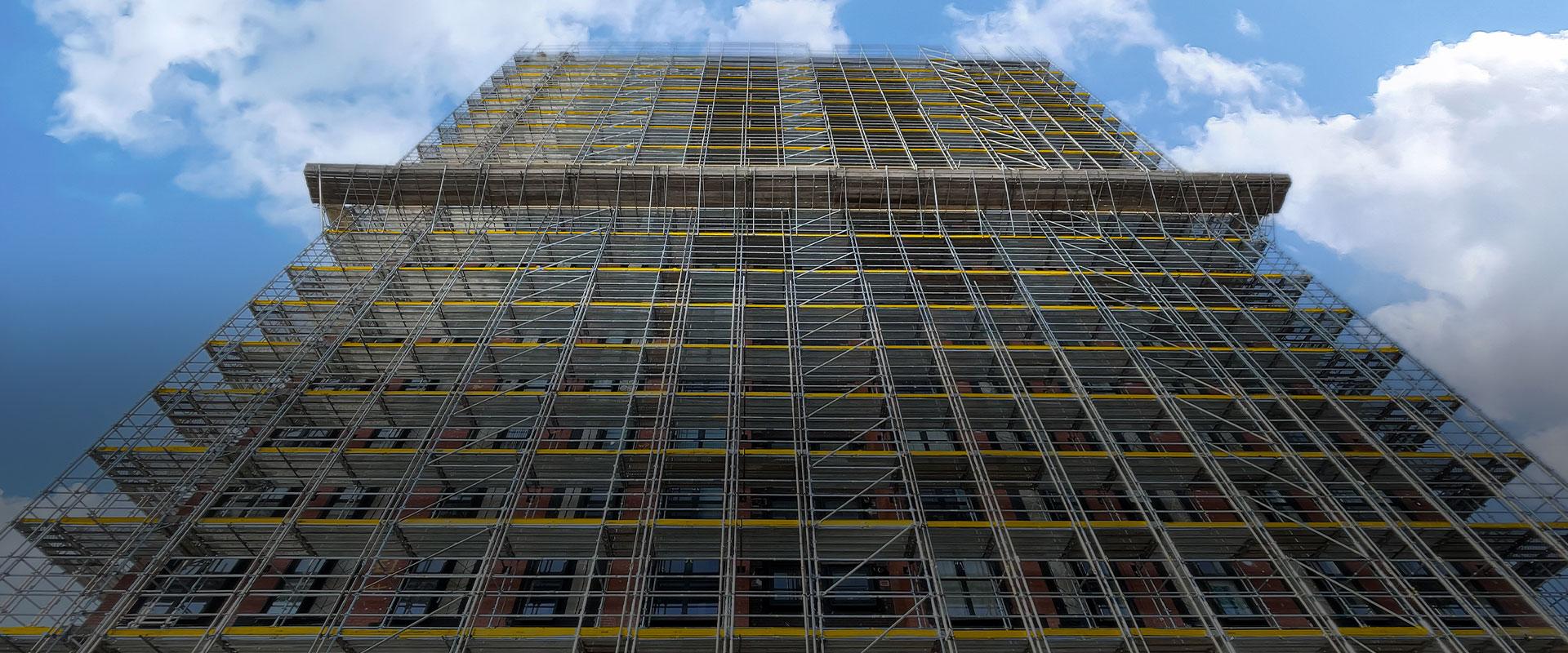Residential Scaffolding Solutions for Safe and Efficient Home Improvements
Residential Scaffolding Solutions for Safe and Efficient Home Improvements
Blog Article
Discovering the Various Types of Scaffolding Utilized in Construction Jobs
The construction market depends greatly on different types of scaffolding to meet certain project demands, each offering distinctive benefits and applications. Traditional frame scaffolding provides a strong foundation for general jobs, while put on hold scaffolding is crucial for work on skyscraper structures.

Conventional Framework Scaffolding
Conventional frame scaffolding is one of the most widely utilized approaches in the building and construction sector as a result of its toughness and adaptability. This system contains vertical and horizontal frameworks that are set up to produce a stable system for materials and employees. The primary components include vertical blog posts, straight journals, and diagonal dental braces, which together provide a strong structure that can sustain considerable loads.
Among the crucial advantages of standard frame scaffolding is its versatility to various building and construction projects, varying from residential structures to huge business structures. The modular layout enables very easy setting up and disassembly, making it effective for both long-term and temporary tasks. Additionally, the system can be personalized in elevation and size, accommodating different structure layouts and site conditions.
Security is extremely important in scaffolding applications, and conventional structure systems are equipped with guardrails and toe boards to avoid drops and make certain worker protection. Moreover, normal inspections and adherence to safety guidelines are critical in maintaining the stability of the scaffold. Overall, typical framework scaffolding continues to be a fundamental choice in the construction industry, offering a trustworthy system for labor and boosting total job effectiveness

Suspended Scaffolding
Suspended scaffolding supplies a special service for construction tasks that need access to raised surfaces, specifically in circumstances where traditional structure scaffolding may be impractical. This sort of scaffolding is usually suspended from the roof covering or upper degrees of a structure, making use of a system of platforms, wheels, and ropes to develop a working room that can be adapted to numerous heights.
Among the primary benefits of suspended scaffolding is its adaptability. It can be easily rearranged or decreased to fit adjustments in building demands, making it suitable for tasks such as home window setup, frontage work, and upkeep on skyscrapers. In addition, the minimal footprint of put on hold scaffolding permits better use of ground room in urban atmospheres, where room is frequently restricted.
Safety and security is an important factor to consider in making use of suspended scaffolding. Appropriate rigging and securing systems need to be used to ensure security and prevent accidents. Operators should likewise be learnt the secure usage of this equipment. In general, suspended scaffolding supplies a effective and efficient remedy for accessing hard-to-reach locations in numerous building and construction scenarios, enhancing both productivity and safety on site.
System Scaffolding
System scaffolding, frequently considered a modern service in the scaffolding market, contains pre-engineered parts that can be promptly set up and adjusted for different construction tasks. Scaffolding. This sort of scaffolding is identified by its modular layout, which permits for adaptability and effectiveness on job websites, fitting different elevations and structural requirements
Commonly made from high-strength steel or aluminum, system scaffolding offers boosted toughness and stability. The parts include upright articles, horizontal journals, and diagonal dental braces, which interconnect safely, guaranteeing a durable framework. The layout typically incorporates standard fittings, simplifying assembly and disassembly procedures, thereby lowering labor time and costs.

Rolling Scaffolding
Rolling scaffolding is a flexible option to standard fixed scaffolding, developed for movement and ease of use on construction websites. This sort of over here scaffolding contains a platform supported by frames with wheels, allowing employees to quickly move it as needed. The mobility attribute significantly boosts performance, as it lessens downtime related to dismantling and putting together repaired scaffolding.
Generally constructed from light-weight materials such as light weight aluminum or steel, rolling scaffolding uses a durable yet portable remedy for jobs requiring constant repositioning - Scaffolding. It is especially advantageous in jobs such as painting, drywall installment, and electrical job, where accessibility to various elevations and locations is essential
Security is paramount in rolling scaffolding layout, with functions such as securing wheels to stop unintended motion when in operation, and guardrails to secure workers from drops. Additionally, several models are adjustable in height, accommodating various job requirements.
Cantilever Scaffolding

The layout of cantilever scaffolding generally involves using brackets or arms secured to a structure or structure, enabling the system to expand exterior securely. Security is critical; thus, these scaffolds must be crafted to stand up to different loads and environmental problems. Routine evaluation and maintenance are essential to make certain architectural stability and worker safety and security.
Cantilever scaffolding is favored for its flexibility and effective use area, making it a preferred selection in urban atmospheres where area constraints prevail. In addition, it assists in simpler accessibility to high elevations, inevitably adding to the total effectiveness of construction tasks. Just like all scaffolding kinds, proper training and adherence to safety and security standards are essential for workers making use of cantilever scaffolding.
Conclusion
To conclude, the diverse types of scaffolding made use of in construction jobs each offer distinct functions customized to specific site needs. Traditional framework scaffolding gives stability, while suspended scaffolding uses versatility for elevated tasks. System scaffolding assists in fast assembly, and rolling scaffolding improves wheelchair for differing workplace. Cantilever scaffolding efficiently attends to barriers in urban setups. Understanding these scaffolding types is necessary for maximizing safety and productivity in building, eventually scaffolding und fading adding to the effective conclusion of tasks.
Traditional frame scaffolding provides a sturdy structure for basic jobs, while put on hold scaffolding is necessary additional info for job on high-rise structures.Moving scaffolding is a functional choice to standard fixed scaffolding, developed for mobility and ease of usage on building and construction websites. As with all scaffolding types, correct training and adherence to safety standards are crucial for workers making use of cantilever scaffolding.
Standard framework scaffolding provides security, while suspended scaffolding offers versatility for raised tasks. System scaffolding facilitates fast assembly, and rolling scaffolding enhances wheelchair for varying job atmospheres.
Report this page